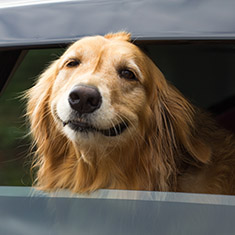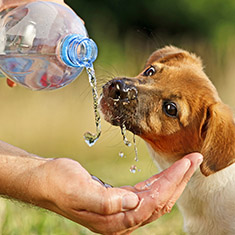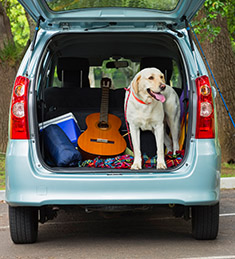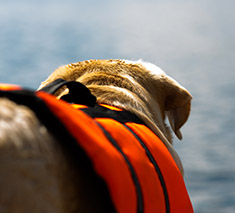Road Trips with your Dog - Best Tips
If you're planning a road trip with a dog, a little advance planning can be the difference between a fun trip and a disastrous one. These nine travel tips for dog vacations include not only packing tips, but advice on how to safely take your dog out of the vehicle at rest stops, and suggestions that will protect your dog in a variety of situations. A few stress busters are included as well.

Taking your dog on a road trip can be an exciting treat for your furry friend, but it can be stressful for you when at the worst possible moment, you realize you forgot to pack an important travel item. Follow these packing tips, and let the vacation be about having fun with your dog instead of panicking along the way.
Fill up milk jugs with water for the road
Water, and an accessible water bowl for pit stops, are two of the most overlooked items in a dog's vacation suitcase. You pull into a gas station and realize that you don't have water for the dog, and end up sneaking a used coffee cup into the bathroom for water, or buying bottled water and trying to figure out what to pour it into.
A simple solution for water is to rinse out milk jugs as you empty them, and then fill them up with water. Keep the jug of water and a dog bowl where you can easily reach them when you pull into rest areas. This offers a secondary benefit once you arrive at your destination, as some dogs throw up for even minor dietary or water changes. Your dog is less likely to throw up when he's drinking water from home, as opposed to water with a different chlorine content, or well water versus city water.

Keep dog treats handy during the drive
Many dogs won't eat regular dog food during the drive, or even once you've settled into the hotel, cabin, camping ground, or friend's house. If it's a long drive and your dog doesn't eat for a day or two, he can end up with an upset stomach when he finally decides to eat, and then wolfs down too much food all at once. Few dogs will turn down treats, however.
Treating your dog with special snacks as you travel makes the trip more fun for the dog, and it keeps his belly from swinging from empty to full at times of travel stress where the swing could upset his tummy.
The type of snack is important, however, as the wrong snack can backfire. Greasy restaurant food which is left over from your lunch might not be a good idea. Dry dog biscuits, pork rinds that you buy for humans at the grocery store, raw baby carrots, and cheese if you're traveling with a cooler, are snacks that few dogs will turn down. The goal isn't to make a full meal out of snacks, you just want to keep your dog's belly from radical empty-to-full swings.
Don't forget the dog harness!
Even if your dog doesn't wear a harness at home, you should harness him during road trips. You wouldn't want him to panic at a rest stop, slip his collar, and bolt into traffic or take off into the woods.

Traveling can be stressful, even if your dog enjoys the trip. Unexpected noises, people, and situations can spook a dog, and it doesn't take much for a frightened dog to slip a regular collar. If your dog embraces adventure, the sight of another dog at a rest area can also spur him to make a break for freedom to chase after the other dog.
During the journey, snap the leash on before you open the car door so that your dog can't push past while you're fumbling to connect him. Have someone inside the vehicle hold the leashed dog, while the person outside opens the door.
Prepare for car sickness
Bring along old towels to clean up any messes, and a change or two of padding. Regardless of whether your dog is loose or crated during the actual drive, there should be padding under him to create a comfortable place to snooze, and to protect your vehicle from accidents.
Thick comforters make excellent padding, and if you don't have old comforters, you can always pick them up cheaply at yard sales or thrift stores. There's an added bonus to traveling with dog comforters, they provide soft dog bedding once you get there.
Give him a dog bath, and make sure he's up to date on his meds

A dog bath a few days before you leave ensures that you won't be cooped up in the vehicle with a stinky dog. It's also a thoughtful gesture so that you aren't carrying dog stink into wherever you stay.
Make sure he's had a recent flea and heartworm treatment. Fleas carry a variety of diseases including tapeworms, and you can bet that he's going to come into contact with fleas along the way from a multitude of strange dogs.
He should be current with his annual vaccinations, not only to ensure that he doesn't catch a deadly disease, but because many vacation rentals require it. Protect him beforehand to prevent an expensive vet visit later.
Tag your dog, inside and out
His dog collar and harness should each have a tag with his name, and your address and phone number, in case he gets loose. Your dog should also be microchipped. Few dog owners are reunited with their lost dogs if the dog gets loose while far from home, especially if there isn't contact info on the dog.
Pack a dog pen and crate
Don't expect your dog's daily routine to be the same during a trip as it is at home. He may have run of the house or yard at home, but when traveling, your dog may need to be penned, even if he's the perfect house guest.
If you're staying with people who have dogs or cats, you'll want a barrier in case they don't get along, or one is much bigger than the other so that the smaller pet doesn't get injured unintentionally. A dog pen is wise around kids as well. It's not just about protecting the kids, it's about protecting the dog from kids who may not treat him with the same gentleness that you do at home.
Another reason to use a dog pen indoors is to prevent him from door dashing. At home, you've got the routine down pat, or perhaps your door leads to a fenced yard. At someone else's house, especially if many people are coming and going as when visiting family, you don't want to worry that someone will inadvertently let him out.
You can invest in a versatile dog pen up to four feet high that can be shaped into a round or square pen, or even used as an indoor "fence" that blocks off one room from another. This type of dog pen folds up almost flat when not in use.
If your dog isn't the best behaved dog in the world, travel with a crate. You don't want your dog chewing up someone else's home when you go out to eat, so be considerate and crate him. Even dog friendly hotels require it, regardless of how well behaved your dog is.
Pack for the destination
If you're going to the beach, pack a life jacket for your dog. Even if he can swim, if you're taking him into deep water as when boating, a life jacket can save his life if he jumps out and tries to swim for shore, and the distance is farther than he can swim. In addition, accidents happen, and if you're in a boat accident, life jackets for humans and pets may be the difference between life and death.

Also, pack a box of zip lock sandwich bags, and a few plastic grocery bags, so that you can scoop poop, especially on the beach. Turn the baggie inside out, insert your hand, and pick up the poop with the baggie. Then you can turn the baggie right side out and zip it shut without ever getting your hands dirty. Deposit the baggie into a plastic grocery bag as a way to carry it until you can toss the baggie into a trash can.
Stress busters can turn a worrisome trip into a joyful trip
Dogs can get stressed out when they're in unfamiliar surroundings, especially when you go off and leave them as you would for meals. Help your dog feel more at home by bringing his favorite toys, bones, and dog bed. After all, you want him to have a fun vacation, so make his space feel like home.
If your vehicle has enough room, create a cozy dog den that he can snuggle up in during the trip. Treats, toys, blankets, and bones that he's already familiar with can ease your dog's stress just by being accessible, even if he doesn't use them.
Give as much thought to packing for the dog as you would for the rest of the family, and your road trip can be fun and exciting instead of a series of disasters. Write out a packing list for the dog, and store it on your computer as a list in a text file to print out a week or two before the trip. Include everything on the list that you might need, and if it isn't relevant for this particular trip, just cross it off this time. Follow these tips and you're on the way to happy trails!
Doggies Den: Latest Articles
 Homemade Thanksgiving Treats for Your Dog
Homemade Thanksgiving Treats for Your Dog
NUTRITION We all want to include our dogs in our holiday celebrations, but hopefully, you're aware that sharing table scraps with your dog isn't always the best idea.
 Keeping Your Dog Safe during the Summer Months
Keeping Your Dog Safe during the Summer Months
HEALTH Summer is coming on fast, so it’s time to plan how you will keep your dog safe and healthy through the lazy, carefree, warm days.
 Vaccination Time Again-Keeping Your Puppy Healthy
Vaccination Time Again-Keeping Your Puppy Healthy
DOG HEALTH So you have your new puppy picked out. There are quite a few shots, treatments and examinations that will keep the newest member of your family healthy.
 Canine Thanksgiving Feast
Canine Thanksgiving Feast
NUTRITION With the wide variety of food at Thanksgiving dinner, chances are you'll want to give your dog something special, too. If you're contemplating what to feed your dog for the holiday, here is a guide to a great Canine Thanksgiving Feast.
 Dog Walking Tips Every Owner Should Know
Dog Walking Tips Every Owner Should Know
DOG FUN Walking your dog is not only crucial to keeping him healthy and happy, it strengthens the bond between your canine friend and his caregiver. There are a lot of obstacles out there. Don’t forget these simple tips to keep your walk fun and safe in the outside world.
 The Benefits of Physiotherapy for your Dog
The Benefits of Physiotherapy for your Dog
HEALTH The same techniques that physiotherapists use to treat a variety of injuries and conditions in humans have been adapted to suit animals with great success. Family pets, show dogs, and working dogs can all benefit greatly from physiotherapy. Dogs whose activities involve a lot of agility are especially susceptible to the types of problems that physiotherapy can address.
 The Decision- Adding a Dog to Your Family
The Decision- Adding a Dog to Your Family
FIRST TIME OWNERSBringing a dog into your family is a decision where many people don’t realize it’s magnitude until after they have the dog. There are a number of things that you need to research before you decide to purchase a dog, and it starts right in your own home.
 Bringing Your Dog Into Your New Baby's Life
Bringing Your Dog Into Your New Baby's Life
HEALTH Many believe that a dog and a new baby cannot happily coexist, so therefore the dog has to go. This is not necessarily the case.  A new baby does not mean you have to abandon your dog.

Doggies Den:
Most Popular Articles

Dog Pregnancy Symptoms
HEALTHIf you suspect your dog might be pregnant, check out part one in this series on pregnant dogs, where we cover pregnant dog symptoms.

Dog Birth
HEALTHIn the third article of our dog pregnancy series, we look at the wonderful, but messy, process of bringing newborn puppies into the world.

Indoor Dog Potties
DOG PRODUCTSIt's been a long day at work. You were so busy, you didn't even take time to eat a sandwich, let alone run home to let your dog out. You're on your way home, knowing the poor dog is crossing his or her legs by now, when your car breaks down, delaying you even further. Can't somebody make this easier?

Your Dog’s Digestive System
PHYSIOLOGYEver wonder why your dog eats so fast? Or why he eats gross things? Or why he gets sick to his stomach? Or why his waste stinks so bad? Some of these things are normal, some are not.

Canine Respiratory System
BREATHINGThe basic function of your dog's respiratory system is to bring oxygen in to and remove carbon dioxide from the body. Knowing the symptoms of respiratory diseases can help you help your stay healthy.

Shelter Dog Adoption Tips for Success
ADOPTION Are you intimidated by the prospect of "rescuing" a dog from a shelter? One reason that you may be wary of adopting a dog from a shelter is not knowing how to choose. Adopting a dog from a shelter can be a rewarding process, if you're prepared to do a reasonable amount of research.

Canine Urinary Tract Infections
SYMPTOMS AND TREATMENTDoes your dog seem to be having trouble relieving his or her bladder? Learn how to recognize the signs of urinary tract infections and how to treat them before they spread.

What to do for Dog Diarrhea
SYMPTOMS AND REMEDIESIf you have dogs in your house for any length of time, you have likely experienced at least one bout of dog diarrhea. Beyond the pain in the tuckus involved in cleaning up the mess, you should know what causes diarrhea, and when it's important to see the vet.

What to do for a Dog Bite
DOG BEHAVIOR Getting bitten by a dog can be scary, and you may be tempted to run around in circles for a while, trying to figure out what to do. Here's our guide to help you manage the situation.

Top Ten Tips for Living with a Senior Dog
DOG HEALTH Bringing home a new puppy is so exciting, but it doesn’t take all that long for your exuberant puppy to grow into a senior dog who may have special needs. Here are the doggies.com top ten tips for taking care of your companion who has been with you through so much.
